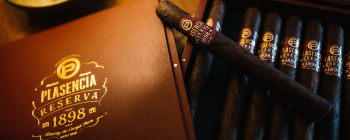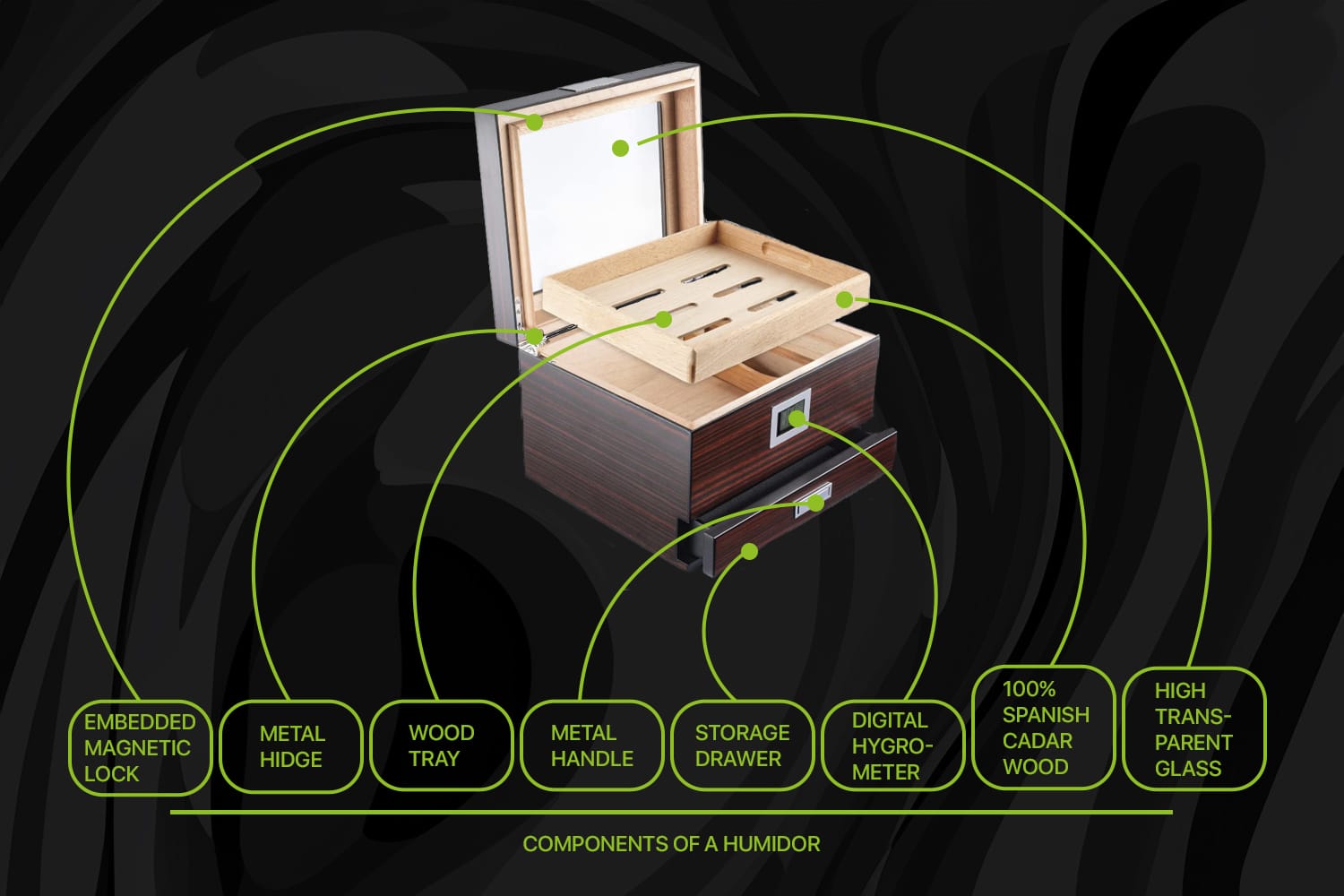Sep 27, 2024
Last Modified: Oct 30, 2025

Owning a humidor is an absolute must for any cigar aficionado. Not only do they give you a place to store your sticks, they also keep them fresh and moist for extended periods. This will help you to maintain their flavor and aroma. In addition, it will allow you to age your cigars in a way that they’ll get better with time.
The humidor is a specialized piece of kit. It is designed with cigar quality in mind, featuring multiple components to help it do its job. In this article, we’ll talk you through these components to answer the question, “how do humidors work?”.
What Is a Cigar Humidor?
A cigar humidor is a storage container that produces humidity to keep your sticks fresh. Cigars left in improper conditions can go bad within hours. However, cigars in a humidor can last for months, if not years.
Humidors contain various components. These include cedar wood lining and hygrometers to measure humidity levels. All of the components in a humidor come together to create the ideal environment for cigars to thrive in.
Understanding Humidity Control
What does a humidor do? Humidity control is its main responsibility. Keeping relative humidity (RH) levels between 65% and 70% is vital for your cigars’ wellbeing. Too little humidity and your cigars will dry out. Too much, and they will become too moist, ruining the flavor, draw, and promoting mold growth.
Humidors will also store your cigars in a perfect temperature for them to thrive. This is around 70°F (21°C), often classed as room temperature. Incorrect temperature levels can also dry out or over-moisten a cigar.
In short, a lack of humidity control can ruin your cigars and prevent them from aging properly. Here’s what will happen if your cigar dries out.
What happens if your cigar dries out?
There are many issues that can arise if your cigar becomes too dry, including:
- Fast, uneven burn: Dried cigars will burn quickly and unevenly, resulting in a harsh and bitter taste. It will also create very hot smoke, which will feel harsh on your throat.
- Cracking/splitting: When a cigar dries out, it becomes brittle. This makes it vulnerable to cracking and splitting. This can lead to the cigar falling apart as you smoke it.
- Loss of essential oils: As the cigar dries out, its essential oils will evaporate. These essential oils are responsible for the complexity of the stick’s flavor. Without them, you’ll have an underwhelming taste in your mouth.
What happens if your cigar becomes too moist?
Conversely, an overly moist cigar will have its own issues, including:
- Mold: Mold thrives in hot, warm climates, and will quickly spread on over-humidified cigars. An overly humidified climate will also encourage tobacco beetle infestations. This can ruin an entire box of cigars.
- Cracking/splitting: Much like dried out cigars, moist sticks will be vulnerable to cracking and splitting. This is because tobacco expands when exposed to moisture. This subsequently causes it to break out of its tightly-filled wrapper.
- Difficult to light: Overly moist cigars are difficult to light, as airflow will be restricted. If you do manage to light the cigar, the burn will likely be uneven, contributing to a poor draw and flavor.
Components of a Humidor

To the untrained eye, cigar humidors may look like regular storage containers. However, they are carefully crafted with specific components that keep your sticks humidified.
Spanish Cedar Construction
Exterior materials vary greatly across different humidors. However, the interiors are almost always lined with Spanish cedar wood. It’s the ideal choice of wood for its purpose, as it absorbs and releases moisture very effectively. This is vital for maintaining consistent humidity levels.
It’s also resistant to mold, decay, and insects, meaning it will remain in peak condition after years of use. Its distinct aroma can even add to the flavor of your sticks over time, which is ideal for cigar aging.
Tight Seal
To work effectively, the internal environment of the humidor needs to remain consistent. Having a tight seal will prevent air from entering or escaping the humidor. This will ensure no change in temperature or humidity levels.
Airtight seals may start to loosen over time. That’s why you should perform regular maintenance checks. An effective testing method is the ‘dollar bill test’. This involves placing a dollar bill, or any form of bank note, on the side of the humidor and shutting the lid. If there is a lot of resistance when you pull the bill out of the humidor, the seal is in good condition.
Humidifier
How does a cigar humidor work? The humidifier is the most important aspect. This is the device that releases the vapor into the air to help maintain the humidity within the humidor. Humidifiers come in multiple forms, including:
- Sponge: A sponge soaked in distilled water is a basic, yet effective form of humidifier. It releases its moisture over time, and will need resoaking every couple of weeks.
- Humidification packs: Boveda humidification packs require a lot less maintenance than sponges. They use distilled water and salt which gets released into the humidor slowly. Boveda packs come in a range of different humidity levels, offering great consistency.
- Crystals: Humidification crystals absorb and release moisture, creating consistent humidity. They don’t need regular maintenance and can be reactivated using a Glycol solution.
Humidification Solution
A humidification solution is essential for most humidifiers. It usually comes in the form of distilled water, as it doesn’t contain minerals that promote mold growth. It can also come in the form of food-standard propylene glycol. Both solutions will regulate the absorption and release of moisture into the environment.
Hygrometer
No humidor is complete without a hygrometer. It is a small device that measures relative humidity (RH). RH is the percentage of water vapor in an environment. In your humidor, you’ll want to achieve between 65-70% on your hygrometer.
Hygrometers come in two different forms, digital and analog. Traditional analog hygrometers are effective. However, they aren’t as accurate or easy-to-understand as their digital counterparts.
How Does a Humidor Work? (Step-by-Step)
So, now you know the role of the humidor and its components, you’re probably wondering how to use a humidor.
There are multiple steps to take to get your humidor working effectively. Let’s start with seasoning.
1. Seasoning the Humidor
Seasoning is an alternative term for preparing the interior of your humidor for use. It involves adding the right amount of moisture to the humidor’s cedar wood. This will help you reach the desired interior humidity level. If you fail to add moisture to the cedar wood, it will start to absorb it from the cigars instead. This will result in your sticks drying out.
Here’s how you season a humidor:
- Prepare the humidor: Start by emptying your humidor of cigars, and wiping the interior with a dry cloth. The aim here is to remove any dust particles contained in the humidor.
- Insert a bowl of water or solution: Place a shallow bowl of distilled water, propylene glycol solution into the humidor. Always use distilled water. Tap water contains minerals that can contaminate the humidor and promote mold growth. Seal the humidor and leave the bowl for three to five days.
- Or use a Boveda pack: Alternatively, you can insert an 84% Boveda seasoning pack. This process will take around 14 days.
- Measure humidity: After you’ve left your humidor for a few days, use a hygrometer to measure the humidity. The number you’re aiming for is between 75-80%. This is higher than the storage range, but your cigars will absorb the excess moisture.
2. Adding Cigars and Maintaining Humidity
After seasoning, it’s time to start placing your cigars in the humidor. Ideally, you’ll want to fill the humidor to at least half of its capacity. This will help create the right internal conditions. Also, always be sure to leave at least 20% of the humidor free, to allow air to pass freely.
Now your cigars are in storage, you’ll want to perform regular checks on the humidor. This will ensure that conditions have settled and aren’t exceeding the 70% humidity limit.
If your humidor is becoming too humid, you can:
- Open the humidor for a short while to allow moisture to escape
- Remove cigars from the humidor and take out any humidifiers
- Add cedar strips to absorb any excess moisture
- Move your humidor to a cool dark place
- Recalibrate your hygrometer and double check RH levels
If your humidor falls below the 65% RH mark, you can:
- Add distilled water to the humidor
- Add a Boveda pack or crystals to the humidor
- Reseason the humidor entirely
- Remove your cigars and perform a deep clean on the humidor
3. Long-Term Storage and Aging
If you plan on storing your cigars for many months, or even years, your humidor will play a key role. The process of aging cigars isn’t just a case of placing them in the humidor and forgetting about them, however. You’ll have to take regular steps to ensure your cigars mature instead of rotting.
- Humidor storage: For a start, you won’t want to store your humidor in direct sunlight. Humidors aren’t heat-proof, and will need to be stored in a cool, dark place, such as a cupboard.
- Frequent rotation: To properly age your cigars, they will require frequent rotation while in the humidor. This will ensure that they receive even humidity distribution.
- Remove plastic wrapping: Plastic wrappers or cling film will prevent steady airflow around your cigars. To age them effectively, you’ll want to remove the plastic before placing the cigars in the humidor.
The better you store your cigars, the longer their lifespan will be. Frequent maintenance is a must. The temperature and humidity levels will need to be specific in order to keep the cigars fresh for a long time.
4. Maintenance
The work doesn’t stop once your cigars are in the humidor. Frequent maintenance is key to ensure that the right climate levels are present. This can be carried out every one to two weeks.
It’s recommended that you also check up on the workings of your humidor. This includes testing the tightness of the seal. It’s important that you check for any issues with the humidor’s external and internal structure.
If you’ve experienced mold issues, make sure the humidor is 100% clean and mold-free. You don’t want to risk further contaminating any more cigars.
Troubleshooting Common Issues
Humidors aren’t immune to problems. For example, seals may loosen and humidity may rise. Here are a handful of issues and ways to solve them:
Loose Seal
If your humidor’s seal becomes loose, it can affect the internal conditions. To test the condition of your seal, you should try the dollar bill test mentioned earlier.
- Insert a dollar bill on the side of the humidor and shut the lid. Be sure to leave half of the bill hanging outside of the humidor.
- Gently pull the dollar bill towards you. Be sure to take care, as you don’t want to rip the bill.
- If the bill has a lot of resistance and can’t be easily pulled out, your seal will be in good condition.
If you can easily slide your dollar bill out of the humidor, it means your seal isn’t airtight. If so, it will either need repairing or replacing. If it isn’t airtight, you risk allowing air in and out. This will compromise the interior conditions of the humidor.
No Hygrometer
If your hygrometer is faulty there’s no need to panic. While you wait for your new one to arrive, you can test the condition of your cigars manually. Do so by using what’s known as the ‘pinch test’. Here’s how:
- Select a cigar out of your humidor and hold it between your thumb and forefinger. You’ll want to be light-handed so as not to cause damage.
- Pinch the cigar along its length, from foot to cap.
- Assess how much resistance you feel when pinching the cigar. It should feel firm with slight give. Not too hard and not too spongey.
- Judge the consistency of your pinches across the entirety of the cigar. Ideally, the cigar will feel the same all the way along.
- When performing your pinches, listen for cracking sounds. These can indicate that your cigar has dried out.
- Perform one last visual inspection to make sure everything looks uniformed and correct. Look out for minor damage, including slight rips and tears
Dry or Overly Humid Humidor
If your humidor is too dry, you will need to reseason it. You can do so by sprinkling a small amount of distilled water onto the cedar wood. There’s also the option of inserting a Boveda pack into the humidor.
If the humidor is too humid, you can open up the lid and let it breathe for a while. It may also be a sign that your humidor is too full. If so, remove a few cigars to encourage better airflow around the interior.
Frequent Traveling
If you want to smoke while away from home, you won’t have to worry about your cigars drying out in your case. Travel humidors can keep your cigars humidified and secure. They will also take up minimal space.
Take Your Humidor to the Next Level
Understanding how humidors work will help you keep your sticks fresh and full of life. With proper seasoning and careful maintenance, humidors are far simpler than they appear. Using and maintaining them well will even help you to age your cigars. This will open you up to a whole new world of smoking pleasure.
However, no humidor is fully complete without the addition of premium quality cigars. At Swiss Cuban Cigars, we stock the very best sticks that Cuba has to offer. Whether you prefer mildness, or maduro-wrapped cigars for aging, we’ve got you covered.
Browse our store now, and fill your humidor with your new favorite smoke.






